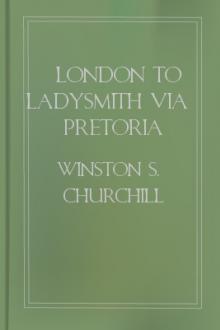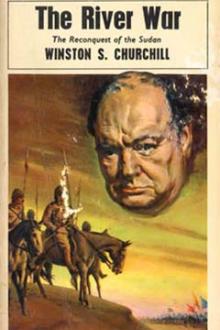London to Ladysmith via Pretoria - Winston Churchill (some good books to read TXT) 📗

- Author: Winston Churchill
- Performer: -
Book online «London to Ladysmith via Pretoria - Winston Churchill (some good books to read TXT) 📗». Author Winston Churchill
During the 15th and 16th a desultory artillery duel proceeded on both sides with slight loss to us. The water question presented some difficulty, as the Blue Krantz River was several miles from Hussar Hill and the hill itself was waterless. A system of iron tanks mounted on ox waggons was arranged, and a sufficient though small supply maintained. The heavy artillery was also brought into action and strongly entrenched. The formidable nature of the enemy's position and the evident care with which he had fortified it may well have added to the delay by giving cause for the gravest reflection.
On the afternoon of the 16th Sir Redvers Buller resolved to plunge, and orders were issued for a general advance at dawn. Colonel Sandbach, under whose supervision the Intelligence Department has attained a new and a refreshing standard of efficiency, made comprehensive and, as was afterwards proved, accurate reports of the enemy's strength and spirit, and strongly recommended the attack on the left flank. Two hours before dawn the army was on the move. Hart's Brigade, the 6-inch and other great guns at Chieveley, guarded Railhead. Hlangwani Hill, and the long line of entrenchments rimming the Green Hill, were masked and fronted by the display of the field and siege batteries, whose strength in guns was as follows:
Guns
Four 5-inch siege guns.......................... 4
Six naval twelve-pounder long-range guns........ 6
Two 4.7-inch naval guns.............................. 2
One battery howitzers........................... 6
One battery corps artillery (R.F.A.)............ 6
Two brigade divisions R.F.A ....................36
One mountain battery............................ 6
—
66
and which were also able to prepare and support the attack on Cingolo Neck and Monte Cristo Ridge. Cingolo Ridge itself, however, was almost beyond their reach. Lyttelton's Division with Wynne's Fusilier Brigade was to stretch out to the eastward and, by a wide turning movement pivoting on the guns and Barton's Brigade, attack the Cingolo Ridge. Dundonald's Cavalry Brigade was to make a far wider detour and climb up the end of the ridge, thus making absolutely certain of finding the enemy's left flank at last.
By daybreak all were moving, and as the Irregular Cavalry forded the Blue Krantz stream on their enveloping march we heard the boom of the first gun. The usual leisurely bombardment had begun, and I counted only thirty shells in the first ten minutes, which was not very hard work for the gunners considering that nearly seventy guns were in action. But the Artillery never hurry themselves, and indeed I do not remember to have heard in this war a really good cannonade, such as we had at Omdurman, except for a few minutes at Vaal Krantz.
The Cavalry Brigade marched ten miles eastward through most broken and difficult country, all rock, high grass, and dense thickets, which made it imperative to move in single file, and the sound of the general action grew fainter and fainter. Gradually, however, we began to turn again towards it. The slope of the ground rose against us. The scrub became more dense. To ride further was impossible. We dismounted and led our horses, who scrambled and blundered painfully among the trees and boulders. So scattered was our formation that I did not care to imagine what would have happened had the enemy put in an appearance. But our safety lay in these same natural difficulties. The Boers doubtless reflected, 'No one will ever try to go through such ground as that'—besides which war cannot be made without running risks. The soldier must chance his life.
The general must not be afraid to brave disaster. But how tolerant the arm-chair critics should be of men who try daring coups and fail! You must put your head into the lion's mouth if the performance is to be a success. And then I remembered the attacks on the brave and capable General Gatacre after Stormberg, and wondered what would be said of us if we were caught 'dismounted and scattered in a wood.'
At length we reached the foot of the hill and halted to reconnoitre the slopes as far as was possible. After half an hour, since nothing could be seen, the advance was resumed up the side of a precipice and through a jungle so thick that we had to cut our road. It was eleven o'clock before we reached the summit of the ridge and emerged on to a more or less open plateau, diversified with patches of wood and heaps of great boulders. Two squadrons had re-formed on the top and had deployed to cover the others. The troopers of the remaining seven squadrons were working their way up about four to the minute. It would take at least two hours before the command was complete: and meanwhile! Suddenly there was a rifle shot. Then another, then a regular splutter of musketry. Bullets began to whizz overhead. The Boers had discovered us.
Now came the crisis. There might be a hundred Boers on the hill, in which case all was well. On the other hand there might be a thousand, in which case——! and retreat down the precipice was, of course, quite out of the question. Luckily there were only about a hundred, and after a skirmish, in which one of the Natal Carabineers was unhappily killed, they fell back and we completed our deployment on the top of the hill.
The squadron of Imperial Light Horse and the Natal Carabineers now advanced slowly along the ridge, clearing it of the enemy, slaying and retrieving one field cornet and two burghers, and capturing ten horses. Half-way along the Queen's, the right battalion of Hildyard's attack, which, having made a smaller detour, had now rushed the top, came into line and supported the dismounted men. The rest of the Cavalry descended into the plain on the other side of the ridge, outflanking and even threatening the retreat of its defenders, so that in the end the Boers, who were very weak in numbers, were hunted off the ridge altogether, and Cingolo was ours. Cingolo and Monte Cristo are joined together by a neck of ground from which both heights rise steeply. On either side of Monte Cristo and Cingolo long spurs run at right angles to the main hill.
By the operations of the 17th the Boer line had been twisted off Cingolo, and turned back along the subsidiary spurs of Monte Cristo, and the British forces had placed themselves diagonally across the left of the Boer position thus:
Plan of position at Monte Cristo
The advantages of this situation were to be enjoyed on the morrow.
Finding our further advance barred by the turned-back position the enemy had adopted, and which we could only attack frontally, the Cavalry threw out a line of outposts which were soon engaged in a long-range rifle duel, and prepared to bivouac for the night. Cingolo Ridge was meanwhile strongly occupied by the Infantry, whose line ran from its highest peak slantwise across the valley of the Gomba Stream to Hussar Hill, where it found its pivot in Barton's Brigade and the Artillery. The Boers, who were much disconcerted by the change in the situation, showed themselves ostentatiously on the turned-back ridge of their position as if to make themselves appear in great strength, and derisively hoisted white flags on their guns. The Colonial and American troopers (for in the South African Light Horse we have a great many Americans, and one even who served under Sheridan) made some exceedingly good practice at the extreme ranges. So the afternoon passed, and the night came in comparative quiet.
At dawn the artillery began on both sides, and we were ourselves awakened by Creusot shells bursting in our bivouac. The enemy's fire was chiefly directed on the company of the Queen's which was holding the top of Cingolo, and only the good cover which the great rocks afforded prevented serious losses. As it was several men were injured. But we knew that we held the best cards; and so did the Boers. At eight o'clock Hildyard's Brigade advanced against the peak of the Monte Cristo ridge which lay beyond the neck. The West Yorks led, the Queen's and East Surrey supported. The musketry swelled into a constant crackle like the noise of a good fire roaring up the chimney, but, in spite of more than a hundred casualties, the advance never checked for an instant, and by half-past ten o'clock the bayonets of the attacking infantry began to glitter among the trees of the summit. The Boers, who were lining a hastily-dug trench half way along the ridge, threatened in front with an overwhelming force and assailed in flank by the long-range fire of the Cavalry, began to fall back. By eleven o'clock the fight on the part of the enemy resolved itself into a rearguard action.
Under the pressure of the advancing and enveloping army this degenerated very rapidly. When the Dutchman makes up his mind to go he throws all dignity to the winds, and I have never seen an enemy leave the field in such a hurry as did these valiant Boers who found their flank turned, and remembered for the first time that there was a deep river behind them. Shortly after twelve o'clock the summit of the ridge of Monte Cristo was in our hands. The spurs which started at right angles from it were, of course, now enfiladed and commanded. The Boers evacuated both in great haste. The eastern spur was what I have called the 'turned-back' position. The Cavalry under Dundonald. galloped forward and seized it as soon as the enemy were seen in motion, and from this advantageous standpoint we fired heavily into their line of retreat. They scarcely waited to fire back, and we had only two men and a few horses wounded.
The spur on the Colenso or western side was none other than the Green Hill itself, and judging rightly that its frowning entrenchments were now empty of defenders Sir Redvers Buller ordered a general advance frontally against it. Two miles of trenches were taken with scarcely any loss. The enemy fled in disorder across the river. A few prisoners, some wounded, several cartloads of ammunition and stores, five camps with all kinds of Boer material, and last of all, and compared to which all else was insignificant, the dominating Monte Cristo ridge stretching northward to within an easy spring of Bulwana Hill, were the prize of victory. The soldiers, delighted at the change of fortune, slept in the Boer tents—or would have done had these not been disgustingly foul and stinking.
From the captured ridge we could look right down into Ladysmith, and at the first opportunity I climbed up to see it for myself. Only eight miles away stood the poor little persecuted town, with whose fate there is wrapt up the honour of the Empire, and for whose sake so many hundred good soldiers have given life or limb—a twenty-acre patch of tin houses and blue gum trees, but famous to the uttermost ends of the earth.
The victory of Monte Cristo has revolutionised the situation in Natal. It has laid open a practicable road to Ladysmith. Great difficulties and heavy opposition have yet to be encountered and overcome, but the word 'impossible' must no longer be—should, perhaps, never have been used. The success was won at the cost of less than two hundred men killed and wounded, and surely no





Comments (0)